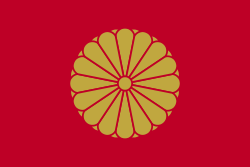Emperor Sushun
| Sushun | |
|---|---|
| Emperor of Japan | |
| Reign | 588–593 |
| Predecessor | Yōmei |
| Successor | Suiko |
| Born | 520/521 |
| Died | 593 (aged 72) |
| Burial | Kurahashi no oka no e no misasagi (Nara) |
Emperor Sushun (崇峻天皇 Sushun-tennō, died 592) was the 32nd emperor of Japan,[1] according to the traditional order of succession.[2]
Sushun's reign spanned the years from 587 through 592.[3]
Traditional narrative
Before his ascension to the Chrysanthemum Throne, his personal name (his imina)[4] was Hatsusebe-shinnō, also known as Hatsusebe no Waka-sazaki.[5]
His name at birth was Hatsusebe no Miko (長谷部皇子). He was the twelfth son of Emperor Kimmei. His mother was Oane-no-kimi (小姉君), a daughter of Soga no Iname,[6] who was the chief, or Ō-omi, of the Soga clan.
He succeeded his half brother, Emperor Yōmei in 587, and lived in the Kurahashi Palace (Kurahashi no Miya) in Yamato.[7]
- 587: In the 2nd year of Yōmei-tennō 's reign (用明天皇2年), the emperor died, and despite a dispute over who should follow him as sovereign, the succession (‘‘senso’’) was received by another son of Emperor Kimmei, one of Yōmei's younger brothers. Shortly thereafter, Emperor Sushun is said to have acceded to the throne (‘‘sokui’’).[8]
Sushun's contemporary title would not have been Tennō, as most historians believe this title was not introduced until the reigns of Emperor Tenmu and Empress Jitō. Rather, it was presumably Sumeramikoto (皇尊) or Amenoshita Shiroshimesu Ōkimi (治天下大王), meaning "the great king who rules all under heaven." Alternatively, Sushun might have been referred to as (ヤマト大王/大君) or the "Great King of Yamato."
He came to the throne with the support of the Soga clan and Empress Suiko, his half sister and the widow of Emperor Bidatsu. Initially, the Mononobe clan, a rival clan of the Sogas, allied with Prince Anahobe, another son of Kimmei, and attempted to have him installed as emperor. Soga no Umako, who succeeded his father as Ōomi of the Soga clan, eventually killed Mononobe no Moriya at the Battle of Shigisan, the head of the Mononobe clan, which led to its decline. Umako then installed Emperor Sushun on the throne.
As time went on, Sushun eventually became resentful of Umako's power, and wanted him deposed. It is said that one day, he saw a wild boar and proclaimed, "I want to kill Soga Umako like this wild boar." This angered Soga no Umako and, perhaps out of fear of being struck first, Umako had Sushun assassinated by Yamato no Aya no Ataikoma (東漢直駒) in 592.
Emperor Sushun's reign lasted for five years before his death at the age of 72.[6]
The actual site of Sushun's grave is known.[1] This emperor is traditionally venerated at a memorial Shinto shrine (misasagi) at Nara.
The Imperial Household Agency designates this location as Yōmei's mausoleum. It is formally named Kurahashi no oka no e no misasagi.[9]
Genealogy
Sushun had one Empress and two Imperial children.[10]
- Empress: Ōtomo no Koteko,[11] also known as Otehime[12]
- Imperial Prince Hachiko
- Imperial Princess Nishikite
- Consort: Kahakami no Iratsume, a daughter of Soga no Umako
- Wife: Futsuhime, Mononobe no Moriya's younger sister
- Mother Unknown
- Sadayo no Shinno
See also
Notes
- ↑ 1.0 1.1 Imperial Household Agency (Kunaichō): 崇峻天皇 (32)
- ↑ Ponsonby-Fane, Richard. (1959). The Imperial House of Japan, p. 47.
- ↑ Titsingh, Isaac. (1834). Annales des empereurs du Japon, pp. 38–39; Brown, Delmer et al. (1979). Gukanshō, p. 263; Varley, H. Paul. (1980). Jinnō Shōtōki, p. 126.
- ↑ Brown, pp. 264; n.b., Up until the time of Emperor Jomei, the personal names of the emperors (their imina) were very long and people did not generally use them. The number of characters in each name diminished after Jomei's reign.
- ↑ Aston, William. (2005). Nihongi, p. 112.
- ↑ 6.0 6.1 Varley, p. 126.
- ↑ Brown, p. 263; Varley, p. 126.
- ↑ Titsingh, p. 38; Brown, 263; Varley, p. 44; n.b., A distinct act of senso is unrecognized prior to Emperor Tenji; and all sovereigns except Jitō, Yōzei, Go-Toba, and Fushimi have senso and sokui in the same year until the reign of Emperor Go-Murakami.
- ↑ Ponsonby-Fane, p. 420.
- ↑ Brown, p. 263.
- ↑ Jochi Daigaku. (1989). Monumenta Nipponica, Vol. 44, p. 455 – Snippet view.
- ↑ Kawamata municipal website: 絹製品
References
- Aston, William George. (1896). Nihongi: Chronicles of Japan from the Earliest Times to A.D. 697. London: Kegan Paul, Trench, Trubner. OCLC 448337491
- Brown, Delmer M. and Ichirō Ishida, eds. (1979). Gukanshō: The Future and the Past. Berkeley: University of California Press. 10-ISBN 0-520-03460-0; 13-ISBN 978-0-520-03460-0; OCLC 251325323
- Jochi Daigaku. (1989). Monumenta Nipponica, Vol. 44. Tokyo: Sophia University Press. OCLC 1640509
- Ponsonby-Fane, Richard Arthur Brabazon. (1959). The Imperial House of Japan. Kyoto: Ponsonby Memorial Society. OCLC 194887
- Titsingh, Isaac. (1834). Nihon Odai Ichiran; ou, Annales des empereurs du Japon. Paris: Royal Asiatic Society, Oriental Translation Fund of Great Britain and Ireland. OCLC 5850691
- Varley, H. Paul. (1980). Jinnō Shōtōki: A Chronicle of Gods and Sovereigns. New York: Columbia University Press. 10-ISBN 0-231-04940-4; 13-ISBN 978-0-231-04940-5; OCLC 59145842
| Regnal titles | ||
|---|---|---|
| Preceded by Emperor Yōmei |
Emperor of Japan: Sushun 587–593 |
Succeeded by Empress Suiko |
| ||||||||||||||||||||||||||||||||||||||||||||||||||||||||||||||||||||||||||||||||||||||||
